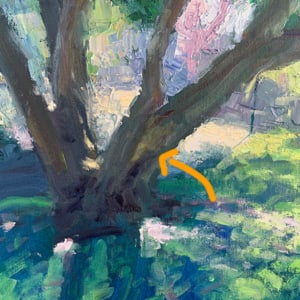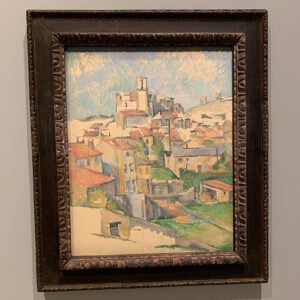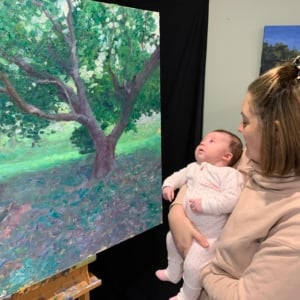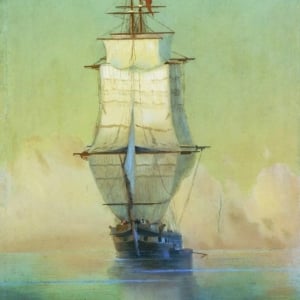Waterfalls are a fantastic subject to paint, particularly as a study of edges, color, and movement. But they can be challenging, with all the twists, turns, breaks, reflections, and turbulence as the water crashes down through the rocks. In this post, I will provide you with some guidelines for painting waterfalls, using master paintings and my study below as examples. I cover:
- Simplifying the Shapes and Forms
- Capturing the Flow and Movement of the Water
- Using Color
- Rigid Rocks and Flowing Water
- Key Takeaways
- Want to Learn More?
- Thanks for Reading!

(Before diving into this post, make sure to pick up a copy of my free Landscape Painting Starter Kit.)
Simplifying the Shapes and Forms
One of the major challenges of painting waterfalls is simplifying all the chaos of the quick-moving water into something which makes sense in a painting. If you start by trying to paint every twist, turn, and splash of water, you will likely end up with an incoherent mess on the canvas. You need to start with big-picture shapes and forms, then build up detail on top of that.
Below is the reference photo which I painted from, taken on a recent trip to New Zealand. I will run through how I go about simplifying the waterfall into basic shapes and forms.

I first try to break the water down into simple shapes. Below is a rough example, with orange representing the lights and blue representing the darks of the water. The darks, in this case, are areas where the water is in shadow, areas where cast shadows from surrounding rocks and shadows are hitting, and areas where the dark rocks are showing through.
It is important to separate the lights and darks early in the painting because they are important for giving a sense of form to the water (most of the time you do not want to be using just one color to paint the whole waterfall).

When I started this painting, I stained the canvas with raw umber then rubbed away some of the paint with solvent and a cloth to indicate the light areas in the waterfall and the general flow of water. Kind of like a negative painting, where you depict form by lifting paint, rather than applying it.
These few simple but important markings give me a feel for the composition and where everything is located.

The other major shapes you will be dealing with in waterfall painting are the rocks, trees, and any other objects in the water. In this case, there are some large, scattered rocks impeding the flow of water. I used a round brush to sketch the outlines of these rocks. I was careful to get the sketch as accurate as possible. More time spent at this stage on the sketch means time saved later in the painting fixing mistakes.

A simple color block-in provided a solid foundation for the painting and gave me an idea of all the shapes and forms. From here, I was able to add detail and start capturing the movement of the water.

Capturing the Flow and Movement of the Water
Once you have a rough idea of the shapes and forms, you need to focus on capturing the flow and movement of the water. The last thing you want is a blocky and rigid waterfall. You need to really feel the twists and turns in the water as it crashes around.
Have a think about what the gesture of the water is. If you could only use one continuous line to draw the waterfall, what would it look like?
Here are some other questions to ask yourself: How fast is the water moving? What direction? It is hitting a rock and spraying outwards? Is it in freefall? Is it running over rocks or something flat like sand?
The flow of a waterfall will typically twist, turn, stop, and start as it hits rocks, trees, and other objects on the way down. It is rarely one continuous and smooth flow. So your brushwork should match the varied nature of the waterfall.
Use smooth and long strokes for relatively calm areas of water or water in freefall; impasto brushwork for whitewash or turbulent water; and small dabs of color to pick up water spraying off rocks and trees. The scumbling technique is also particularly effective to depict the hazy spray at the bottom of a waterfall.
Having said that, you also need to retain an overall sense of continuation of the water. The water may stop flowing in certain areas, but as a whole, it needs to appear like it is flowing down somewhere.
In the reference photo below I have indicated where the water is flowing. It is a good practice to try and follow the water with your eyes when painting waterfalls, so you get an idea of how and where the water is moving. If you don’t understand the water, then you will struggle to paint it realistically.

John Singer Sargent’s watercolor The Athenaeum, Mountain Waterfall is a great example of capturing the movement of water without overdoing it on the detail. A few long, downward sloping strokes and areas of exposed paper for whitewash are more than enough to give a feel of the water as it flows down through the rocks. You can really feel the water as it falls, crashes, and comes to a rest.

Using Color
Here are some points on using color when painting waterfalls:
- You can use color to reiterate the form of the waterfall. See if you can break the water down into two parts: part in light and part in shadow. I did this for the reference photo at the start of the post in orange and blue. Then do your best to keep these areas distinct.
- Be aware of any cast shadows from surrounding trees or rocks and make sure you use darker colors for these areas. Also, be mindful that the shadows may be darker than they appear. When painting things which we understand to have a white local color, they can appear lighter than they actually are in shadow. There is a painting by Sargent towards the end of this post named Yoho Falls which demonstrates some beautiful work with the cast shadows on the waterfall.
- The colors will probably change every time there is a change in plane or the nature of the water, from the flat surface just before the fall, to the edge, to the waterfall itself, to the turbulent whitewater, to the calm body of water at the bottom. Use color to capture or emphasize these changes. For areas of turbulent whitewater, light grays and white will probably be suitable. For calmer and more transparent areas, you might want to introduce more color. The painting below is a great example of using color to suggest changes in the plane and the nature of water.

- Be careful with white; many artists tend to overuse it when painting waterfalls. I would only use pure white for the brightest of highlights, if at all. Most of the time you should be using grays and other weak colors. In Thomas Hill’s A Waterfall In The Sierras, pure white only seems to be used for the very top of the waterfall. The colors get gradually more dull and gray towards the bottom of the waterfall. Also, on a separate note, observe how the waterfall merges into one with the grays of the cliff faces at the bottom.

- To indicate wetness on rocks and trees, you may want to paint some partial reflections. In the reference photo (below), you can see some of the rocks around the center are wet and partially reflecting the colors of the waterfall.

Rigid Rocks and Flowing Water
A key feature of waterfall paintings is the beautiful contrast between the rigid rocks and the flowing water. It is usually a good idea to really try and push this contrast. Here are some examples of how you might go about doing so:
- Use solid and rigid brushwork for the rocks and fleeting and loose brushwork for the water.
- Use hard edges for the rocks and soft edges for the water.
- Use dark colors for the rocks and light colors for the water.
- Use thin paint for the rocks and thick paint for the water (or vice versa).
- Use solid colors for the rocks and varied colors for the water (or vice versa).
In Sargent’s Yoho Falls, the water appears organic and connected as it flows down through the rocks. The rest of the landscape is rough and jagged, with sharp highlights and deep shadows. Also, take note of Sargent’s attention to detail in painting all the cast shadows on the waterfall.

(Note: You can see more famous waterfall paintings, like this one by John Singer Sargent, on the waterfall gallery page.)
Key Takeaways
Here are some of the key takeaways from this post:
- Simplify the water down to basic shapes and forms. You don’t want your waterfall to appear flat. What would the waterfall look like if it was just made up of basic shapes and forms?
- Try to capture the movement and flow of the water. Think about the overall gesture of the waterfall.
- Try to match the nature of your brushwork to the nature of the water. For example, use rough brushwork for rough whitewater. Or calm brushwork for calm water.
- Use color to help reiterate form and pick up any changes in the plane or nature of the water.
- Be careful not to overuse white.
- Think about what you are trying to say in the painting and really try to push in that direction. For waterfall paintings, it is usually a good idea to really push the contrast between the rigid rocks and the flowing water.

Want to Learn More?
You might be interested in my Painting Academy course. I’ll walk you through the time-tested fundamentals of painting. It’s perfect for absolute beginner to intermediate painters.
Thanks for Reading!
I appreciate you taking the time to read this post and I hope you found it helpful. Feel free to share it with friends.
Happy painting!
Dan Scott

Draw Paint Academy







Thank you for all these awesome tips on waterfalls. I tried many times but gave up, I couldn’t get the waterfalls to look right. I’m going to try it again now. Feeling better about attempting again since I love waterfalls, so soothing.
Thank you so much for this post, Dan! I just spent the weekend in the mountains and took pictures of waterfalls and am eager to get started painting from them. Your posts are so helpful, because you break things down step-by-step and keep it organized and logical. You are an excellent teacher. Again, many thanks!
As always, very thought provoking. Thank you for your wonderful teaching.
Crystal
Thank you so very 😀much.
This is one of the best lesson on colour form and painting .
You have explained every step and stage so clearly .
I am looking forward to having a go and trying to produce a piece of my own, based on photos from a past holiday that I have been thinking of painting.
Thank you ,really enjoying your posts
Beautifully clear and informative. Very much appreciated! Thank you.
Very helpful, thank you.
Hi Dan,
I just wanted to tell you how much I appreciate your wonderful, informative articles. They have helped my painting tremendously! It’s so nice that you make this available to so many struggling artists and help them in this way.
So, a big THANKS!
Victoria Piebenga
A big Thank You, very clear and very helpful 🌷
Muchas gracias por sus enseñanzas.
Appreciate how you explained all of that. Thankyou for including the reference photos and explaining them. Can tell you are a great teacher!
Many thanks again! Love the challenge, and learned more about a great subject to try.
Inspired Always,
Janet M
Thsnks – that was a great lesdon with good examples!
I’m overwhelmed but will try again, following your step-by-step instructions. Thank you for taking the time to give such thorough, clear instructions. Much appreciated. How long did it take for you to do your painting?
Hi BJ. This was probably about an hour or two of painting time (with breaks in between).
Thanks! Dan
Thank you for this lesson. It is still my wish to paint a waterfall. Because it is very wonderful. Amazing the strength of the water over the rocks. And the colours between the rocks and the water. When the sun shines on the water than it is a miracle from colours. You have shown us now how we have to paint a waterfall. You give us many wonderful lessons. THANK YOU VERY MUCH.
Thank you for this interesting lesson
Thank you Dan! I really enjoy your teaching style, full of valuable information and lots of motivation 🙂
Also I love your ebook (21 Easy Ways To Improve Your Paintings).
Thankyou Dan for this very informative lesson. Really must try a waterfall!
Thank You so much for this steps how to painting waterfalls , beacuse I am in same positon like
Elizabeth, yesterday eraly in the evening I come back for mountain Mosor which has a river Cetina canyon witk mouch photos of Gubavica
waterfalls and wish to pain and do not Know how,now I Know, thank You so much and everything the best I wish to You for bottom of my heart and soul.
God bless You
Love it and bookmark it..thanks
your info is the best i have ever come across. the only problem i have is are all methods the same with all your info & paintings ,when it is done in WATER,OIL ACRYLICS? Or do they apply the same. Maybe i am just dense. I do learn from you though . You do teach great.
Thanks Ernest! Appreciate the very kind words. Most of the information applies to all mediums, however the techniques and processes will change. Things to do with color, shape, composition, edges, etc are fairly universal in art. Thanks!
Dan
The way you laid out the lesson using your drawings and paintings by other artists brought the text to life and made the concepts easy to understand. Thanks so much!
The arrows indicating water flow direction was extremely helpful to me. Thank you
Don’t want to give you a big head Dan, but this is a good post. Very clear explananations on the various aspects of painting flowing water.
Thanks again, Dave M (AUSTRALIA) 😎🇦🇺
Another wonderful lesson! Thank you so much!
Dan… You have freed me from trying to be perfect which, of course, I could never achieve. I find all your lessons to be informative and I’m very happy to be a member of your classes. You inspire me.
Dear Dan
Highly appreciate the detailed lesson. Even though I dabble in watercolour your insights help me, a self taught person, in how to approach a picture to paint.
Thank you
Thank you for breaking this process down into easy to follow steps —- less intimidating!
Great learning as always.
Best pointers especially simplifying the waterfall to basic shapes and forms. I’ve never had anyone point that our and constantly learning through tutorials. Thank you Dan!
Haven’t painted water rushing over jagged rocks in a long time, and now I want to try it again….thanks to your lesson! You are a true inspiration!
Dan, thank you.i,m having trouble with painting water. I need more. My painting is of a quite pond of water with a few cows in it. I can’t get the translucence, to dead. The day is cloudy, lazy would you please help? I am 86 and hav been painting all my life. Can,t afford to buy any extras but painting is the most precious of gifts.
Hi Pat. Maybe flick me an email and I can take a look at it. Thanks!
Dan
Thank you for this post on water, it has helped me to really think about the early stages of preparation. I am going to give it a shot now.
Thanks Dan, for the beautiful examples you shared. WOW. Also, for all the helpful tips. Going to put them into practice, as best as I can. Stay well Cioc